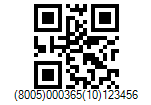

This Symbology is also known as GS1 2D QR Code
This Barcode Symbology is supported by the following Neodynamic products: GS1 QR Code allows you to encode GS1 System Application Identifiers (AI) into QR Code 2D barcodes.
GS1 QR Code allows you to encode GS1 System Application Identifiers (AI) into QR Code 2D barcodes.
GS1 was developed to provide a worldwide format and standard for exchanging common data between companies. While other barcodes simply encode data with no respect for what the data represents, GS1 System encodes data and encodes what that data represents.
GS1 System has a list of Application Identifiers (AI). The Application Identifier is a 2, 3, or 4-digit number that identifies the type of data which follows. By convention, the Application Identifier is enclosed in parentheses when printed below the barcode (the parentheses are only for visual clarity, and are not encoded in the barcode).
GS1 QR Code is based on QR Code ECC200 barcode standard (ISO/IEC 16022), which is a two-dimensional (2D) barcode symbology which can store from 1 to about 2,000 characters, supporting advanced encoding error checking and correction algorithms (reed-solomon).
GS1 System encodes the so called Element Strings which are composed of an Application Identifier (AI) plus a data field. Each AI identifies the meaning and format of the data following it. The code FNC1 (Function 1 Character) is generally used to concatenate two or more data fields in a unique barcode image (FNC1 is automatically handled by Barcode Professional products).
Examples
Encoding single AIs
The following example encodes a Global Trade Item Number (GTIN) 95012345678903 - with AI 01 (Shipping Contained Code) - into a GS1 QR Code barcode
Code property = (01)95012345678903 will produce the following barcode image:


